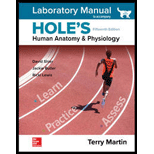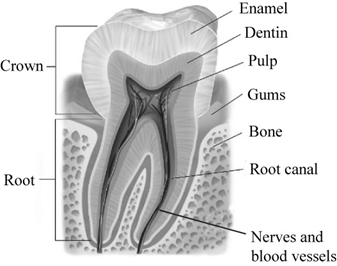
Laboratory Manual for Hole's Human Anatomy & Physiology Cat Version
15th Edition
ISBN: 9781260165401
Author: SHIER, David
Publisher: MCGRAW-HILL HIGHER EDUCATION
expand_more
expand_more
format_list_bulleted
Question
Chapter 17, Problem 11P
Summary Introduction
To describe:
The structure of a tooth.
Introduction:
Teeth present in the mouth helps in mastication and starts the mechanical digestion of food it increases the surface area of food so that digestive enzyme can work more efficiently.
Pictorial representation:
Fig.1:Detailed structure of tooth.

Fig.1:Detailed structure of tooth.
Expert Solution & Answer
Want to see the full answer?
Check out a sample textbook solution
Students have asked these similar questions
When beta-lactamase was isolated from Staphylcoccus aureus and treated with a phosphorylating agent, only the active site, serine was phosphorylated. Additionally, the serine was found to constitute 0.35% (by weight) of this beta-lactamase enzyme. Using this, calculate the molecular weight of this enzyme and estimate the number of amino acids present in the polypeptide.
Based on your results from the Mannitol Salt Agar (MSA) media, which of your bacteria were mannitol fermenters and which were not mannitol fermenters?
help tutor please
Chapter 17 Solutions
Laboratory Manual for Hole's Human Anatomy & Physiology Cat Version
Ch. 17 - Prob. 1PCh. 17 - 2 Which organs constitute the digestive system?
Ch. 17 - 3 Describe the wall of the alimentary canal.
Ch. 17 - Name the types of movements in the alimentary...Ch. 17 - Prob. 5PCh. 17 - Prob. 6PCh. 17 - How does the tongue function as part of the...Ch. 17 - Where are the tonsils located?Ch. 17 - Prob. 9PCh. 17 - How are types of teeth adapted to provide...
Ch. 17 - Prob. 11PCh. 17 - Explain how a tooth is attached to the bone of the...Ch. 17 - Prob. 13PCh. 17 - Prob. 14PCh. 17 - Prob. 15PCh. 17 - Prob. 16PCh. 17 - List the major events of swallowing.Ch. 17 - Prob. 18PCh. 17 - Prob. 19PCh. 17 - Prob. 20PCh. 17 - Why doesn’t the stomach digest itself?Ch. 17 - Prob. 22PCh. 17 - Distinguish among the cephalic, gastric, and...Ch. 17 - Prob. 24PCh. 17 - Prob. 25PCh. 17 - Prob. 26PCh. 17 - Prob. 27PCh. 17 - Prob. 28PCh. 17 - Prob. 29PCh. 17 - List the enzymes in pancreatic juice.Ch. 17 - What are the functions of the enzymes in...Ch. 17 - What regulates secretion of pancreatic juice?Ch. 17 - Locate the liver.Ch. 17 - Review liver functions.Ch. 17 - Prob. 35PCh. 17 - Prob. 36PCh. 17 - Describe the function of the gallbladder.Ch. 17 - How is secretion of bile regulated?Ch. 17 - Prob. 39PCh. 17 - Describe the parts of the small intestine.Ch. 17 - What is the function of an intestinal villus?Ch. 17 - Prob. 42PCh. 17 - Prob. 43PCh. 17 - Prob. 44PCh. 17 - Prob. 45PCh. 17 - Prob. 46PCh. 17 - Prob. 47PCh. 17 - Prob. 48PCh. 17 - Prob. 49PCh. 17 - What stimulus relaxes the ileocecal sphincter?Ch. 17 - Prob. 51PCh. 17 - Prob. 52PCh. 17 - Prob. 53PCh. 17 - Prob. 54PCh. 17 - Prob. 55PCh. 17 - Prob. 56PCh. 17 - Prob. 57PCh. 17 - Prob. 58PCh. 17 - Prob. 59PCh. 17 - Prob. 60PCh. 17 - Prob. 61PCh. 17 - Prob. 1CACh. 17 - Prob. 2CACh. 17 - Prob. 3CACh. 17 - Prob. 4CACh. 17 - Prob. 5CACh. 17 - Prob. 6CACh. 17 - Prob. 7CACh. 17 - Prob. 8CACh. 17 - Prob. 9CACh. 17 - Prob. 10CACh. 17 - Prob. 11CACh. 17 - Prob. 12CACh. 17 - Prob. 13CACh. 17 - Prob. 14CACh. 17 - Describe the locations of the major salivary...Ch. 17 - Prob. 16CACh. 17 - Prob. 17CACh. 17 - Prob. 18CACh. 17 - Prob. 19CACh. 17 - Prob. 20CACh. 17 - Prob. 21CACh. 17 - Prob. 22CACh. 17 - Prob. 23CACh. 17 - Prob. 24CACh. 17 - Prob. 25CACh. 17 - Prob. 26CACh. 17 - Prob. 27CACh. 17 - Prob. 28CACh. 17 - Prob. 29CACh. 17 - Prob. 30CACh. 17 - Prob. 31CACh. 17 - Prob. 32CACh. 17 - Prob. 33CACh. 17 - Prob. 34CACh. 17 - Describe the locations of the parts of the small...Ch. 17 - Prob. 36CACh. 17 - Prob. 37CACh. 17 - Prob. 38CACh. 17 - Prob. 39CACh. 17 - Prob. 40CACh. 17 - Prob. 41CACh. 17 - Prob. 42CACh. 17 - Prob. 43CACh. 17 - Prob. 44CACh. 17 - Prob. 45CACh. 17 - Prob. 46CACh. 17 - Prob. 1IACh. 17 - Prob. 2IACh. 17 - What effect is a before-dinner alcoholic cocktail...Ch. 17 - What type of acid-base imbalance is likely to...Ch. 17 - Prob. 5IA
Knowledge Booster
Learn more about
Need a deep-dive on the concept behind this application? Look no further. Learn more about this topic, biology and related others by exploring similar questions and additional content below.Similar questions
- Q8. A researcher wants to study the effectiveness of a pill intended to reduce stomach heartburn in pregnant women. The researcher chooses randomly 400 women to participate in this experiment for 9 months of their pregnancy period. They all need to have the same diet. The researcher designs two groups of 200 participants: One group take the real medication intended to reduce heartburn, while the other group take placebo medication. In this study what are: Independent variable: Dependent variable: Control variable: Experimental group: " Control group: If the participants do not know who is consuming the real pills and who is consuming the sugar pills. This study is It happens that 40% of the participants do not find the treatment helpful and drop out after 6 months. The researcher throws out the data from subjects that drop out. What type of bias is there in this study? If the company who makes the medication funds this research, what type of bias might exist in this research work?arrow_forwardHow do I determine the inhertiance pattern from the pedigree diagram?arrow_forwardits an open book assignemntarrow_forward
- Describe two different gene regulation mechanisms involving methylationarrow_forwardWhat is behavioral adaptarrow_forward22. Which of the following mutant proteins is expected to have a dominant negative effect when over- expressed in normal cells? a. mutant PI3-kinase that lacks the SH2 domain but retains the kinase function b. mutant Grb2 protein that cannot bind to RTK c. mutant RTK that lacks the extracellular domain d. mutant PDK that has the PH domain but lost the kinase function e. all of the abovearrow_forward
arrow_back_ios
SEE MORE QUESTIONS
arrow_forward_ios
Recommended textbooks for you
 Human Anatomy & Physiology (11th Edition)BiologyISBN:9780134580999Author:Elaine N. Marieb, Katja N. HoehnPublisher:PEARSON
Human Anatomy & Physiology (11th Edition)BiologyISBN:9780134580999Author:Elaine N. Marieb, Katja N. HoehnPublisher:PEARSON Biology 2eBiologyISBN:9781947172517Author:Matthew Douglas, Jung Choi, Mary Ann ClarkPublisher:OpenStax
Biology 2eBiologyISBN:9781947172517Author:Matthew Douglas, Jung Choi, Mary Ann ClarkPublisher:OpenStax Anatomy & PhysiologyBiologyISBN:9781259398629Author:McKinley, Michael P., O'loughlin, Valerie Dean, Bidle, Theresa StouterPublisher:Mcgraw Hill Education,
Anatomy & PhysiologyBiologyISBN:9781259398629Author:McKinley, Michael P., O'loughlin, Valerie Dean, Bidle, Theresa StouterPublisher:Mcgraw Hill Education, Molecular Biology of the Cell (Sixth Edition)BiologyISBN:9780815344322Author:Bruce Alberts, Alexander D. Johnson, Julian Lewis, David Morgan, Martin Raff, Keith Roberts, Peter WalterPublisher:W. W. Norton & Company
Molecular Biology of the Cell (Sixth Edition)BiologyISBN:9780815344322Author:Bruce Alberts, Alexander D. Johnson, Julian Lewis, David Morgan, Martin Raff, Keith Roberts, Peter WalterPublisher:W. W. Norton & Company Laboratory Manual For Human Anatomy & PhysiologyBiologyISBN:9781260159363Author:Martin, Terry R., Prentice-craver, CynthiaPublisher:McGraw-Hill Publishing Co.
Laboratory Manual For Human Anatomy & PhysiologyBiologyISBN:9781260159363Author:Martin, Terry R., Prentice-craver, CynthiaPublisher:McGraw-Hill Publishing Co. Inquiry Into Life (16th Edition)BiologyISBN:9781260231700Author:Sylvia S. Mader, Michael WindelspechtPublisher:McGraw Hill Education
Inquiry Into Life (16th Edition)BiologyISBN:9781260231700Author:Sylvia S. Mader, Michael WindelspechtPublisher:McGraw Hill Education

Human Anatomy & Physiology (11th Edition)
Biology
ISBN:9780134580999
Author:Elaine N. Marieb, Katja N. Hoehn
Publisher:PEARSON

Biology 2e
Biology
ISBN:9781947172517
Author:Matthew Douglas, Jung Choi, Mary Ann Clark
Publisher:OpenStax

Anatomy & Physiology
Biology
ISBN:9781259398629
Author:McKinley, Michael P., O'loughlin, Valerie Dean, Bidle, Theresa Stouter
Publisher:Mcgraw Hill Education,

Molecular Biology of the Cell (Sixth Edition)
Biology
ISBN:9780815344322
Author:Bruce Alberts, Alexander D. Johnson, Julian Lewis, David Morgan, Martin Raff, Keith Roberts, Peter Walter
Publisher:W. W. Norton & Company

Laboratory Manual For Human Anatomy & Physiology
Biology
ISBN:9781260159363
Author:Martin, Terry R., Prentice-craver, Cynthia
Publisher:McGraw-Hill Publishing Co.

Inquiry Into Life (16th Edition)
Biology
ISBN:9781260231700
Author:Sylvia S. Mader, Michael Windelspecht
Publisher:McGraw Hill Education
Human digestive system - How it works! (Animation); Author: Thomas Schwenke;https://www.youtube.com/watch?v=X3TAROotFfM;License: Standard Youtube License